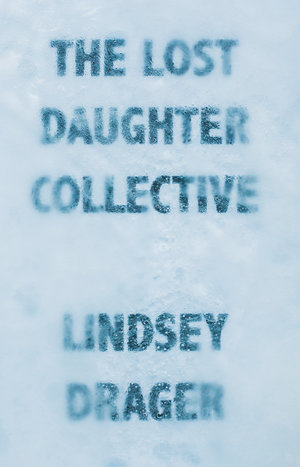
The Lost Daughter Collective
by Lindsey Drager
a review by Joe Sacksteder
Dzanc Books
2017
176 pages
ISBN: 978-1-941088-73-9
All over the United States this last holiday season, many children couldn’t go home for the holidays. There was too much weeping to be done. Many children who went home realized that it wasn’t home any more, maybe never had been. “I went house for the holidays,” they came back saying. Children with children are quarantining their young ones from relatives. This bad time is good timing for Lindsey Drager’s ice labyrinth, The Lost Daughter Collective, which documents all the ways we didn’t know children can go, missing.
This novel is divided into two parts, “The Room with Two Doors” and “The Region of Perhaps.” In each section, the diegesis of the other is presented as non-diegetic material, further destabilizing any attempts to iron the narrative into linearity. In the first part, a father (the Scholar) tells his five-year-old the bedtime story of the Lost Daughter Collective. The Lost Daughter Collective is a group of men who meet on the top floor of an abandoned umbrella factory to mourn the loss of their daughters. In the second section, the story of the Scholar and his daughter takes the form of bygone folklore that a group called FOLD (Fathers of Lost Daughters) failed to finish telling their daughters before their deaths or disappearances.
The stories that the Collective and FOLD relate are a catalogue of paternal neglect reminiscent of macabre German cautionary tales like Max und Moritz and Der Struwwelpeter. In the first section, the members of the Collective have lost their daughters mostly through accident or under mysterious circumstances. The second section, on the other hand, shifts into free adaptations of famous women writers’ difficult relationships with their fathers. My knowledge of Mary Shelley helped me identify William Godwin in the domineering, creativity-quashing father figure of “Mary and her Father,” but the stories of Virginia Woolf and Charlotte Brontë / Perkins-Gilman seemed far more improvisatory. Rather than being intentionally cruel, most of the neglect is a result of fathers failing to understand their daughters’ needs, or failing to think outside of patriarchal cultural norms: “The fathers wanted very much for their daughters to fit certain archaic standards, but their daughters did not. And so the daughters left.”
The structural shift in cautionary tales hinges on the last story that the Scholar tells his daughter in the first section, “The Mystery of the Archivist’s Daughter.” This story is different than the others in that it does not end with the literal disappearance or death of the daughter. The archivist has simply shown up too late to his daughter’s ice sculpture competition to see her prize-winning statue before it melted. The losing of the daughter here must be interpreted as a rending that takes place inside the daughter. Her father is no longer who she’d believed fathers are supposed to be, throwing into uncertainty her daughter status as well. Thus, the daughter deaths and disappearances in the book can now be read metaphorically as the alienation we all feel from our parents to some degree as we grow older. “She cannot help thinking,” Drager writes, “that while the fathers see their girls as lost, the girls interpret their leaving differently.”
It’s no accident that an Archivist is not so different from a Scholar, that the daughter who puzzles over this final story grows up to become the Ice Sculptor. This frame story of Scholar and daughter is subsumed into the cautionary tales and becomes the novel’s overarching fable of carelessness. The Scholar is so caught up in theoretical and ultimately irrelevant work at the Wrist Institute that he fails to warn his daughter of a coming change, the loss of her baby teeth. The bedtime story of the Lost Daughter Collective, it turns out, was far less practical than the advice she needed, thus implicating storytelling itself in the girl’s originary trauma, the same fairytale cloaking of real-life issues in which the novel itself participates. One reason the story of the Collective might be less than helpful for the young girl is that, by focusing the lesson on the father’s pain, it misuses love by putting the daughter in a position of guilt, of obligation not to be the cause of her own father’s anxiety. Less than unhelpful, actually—as the story has the opposite effect on the daughter than the father intended. She spends the rest of her life “exhibit[ing] her fears,” first via shadow puppets, then the ice sculptures that increasingly condemn her father’s mistake.
In one of the novel’s many allusions, a father named Peter—loosely adapted from J.M. Barrie’s writing—appears to emerge as a redemptive father figure. Like the Archivist, Peter “loses” his daughter in a more figurative way: his daughter transitions into a son. Though Peter hears his child in a way that the book’s other fathers do not, though he supports the transition, the reader still gets a sense that Peter is seeing himself rather than his child at the center of the narrative, a reading that is reinforced by the image that ends the novel, the FOLD’s chairs after the adjournment of their meeting compared to “rotting teeth on the bottom of a mouth.” Thus there’s something wrong with reading Peter as an evolutionary leap forward, or at least a perfection of, the father figure—and I think we receive further clues in Drager’s other allusions to children’s literature, namely the Collective’s practice of referring to disappeared daughters as Alices and dead daughters as Dorothies. J.M. Barrie, Lewis Carroll, L. Frank Baum—what do these three writers have in common? They’re men who wrote novels that are commonly passed to children, not directly, but via the mediation of films or abridged storybooks. Why? Because if you actually read the books, they’re totally fucked up. As a writer of strange literature, I mean that mostly as a compliment, but my encounters with these books have left me feeling weird about the overwhelming sanction our culture has given them. The Tin Woodmen is hacked into pieces by his enchanted ax and given tin limbs as prosthetics, for example. Peter Pan eroticizes children, Peter speaking to Wendy “in a voice that no woman has ever yet been able to resist,” for example. Lewis Carroll, for example. Thus Drager’s allusions to diseased children’s literature written by men is positioned in dialectic opposition to the novel’s loose biographies of suppressed female writers, the end effect being to call into question the whole cultural apparatus that has passed to us the formative, canonic literature that we in turn pass to our children. This is the mistake being reenacted by the Scholar throughout the book, the rottenness of male-centric storytelling that fetishizes the bodies of girls while excluding their lived experiences. In a just world, our teeth would fall out for the stories we tell children.
This reading is either reinforced or complicated—I’m not sure—by the suggestion at the end of the novel that Peter’s last name might be Writer. One overriding question of The Lost Daughter Collective is, with all the competing, heteroglot storylines, who is the overarching narrator? The story of the Scholar and his daughter undergoes significant distortion by the time it becomes the FOLD’s folklore; they “corrected” their daughters when they referred to the Scholar as the “father without whisks.” “Risks,” the fathers said, rather than “wrists.” In a Region of Perhaps where all readings are misreadings and all fathers inherently solipsistic, the lesson they fail to learn is how to relinquish control over narratorial authority. The reading that I like best is a Quixotic one: that the girl who grew up to become the Ice Sculptor actually or additionally became the Writer, the last image of the folding chairs as rotten teeth her wink to the reader—however, insisting on this reading would show me perpetuating the fathers’ errors.
At times, the book’s language is comparable to Rabelais’s frozen words that are gradually heard as they thaw on the deck of the ship in Gargantua and Pentagruel. I love “We say that clocks have hands; we say that shoes have tongues. The notion of the wrist, however, has not been admitted into the domain of dead metaphor—in short, nothing else contains a wrist.” But overall the book’s language failed to enchant me. Mainly, because it aims to enchant me too emphatically. It’s this type of language intensive writing in which fairytale simplicity clashes with modernist enstrangement, an unrelenting trend these last twenty years or so. Every sentence seems to turn back at you to ask whether or not you thought it was lovely and weird. One of the book’s mantras, “For every woman in the world, there will always be laughter in slaughter,” seems both meaningless in context and too familiar in its play. (Slaughter in laughter would be more appropriate, or, better yet, ought in daughter.) However, I was quickly made to forget my personal stylistic peeves by the book’s riddle-like, looping structure and the critique of patriarchy it achieves via holding up to scrutiny the narratives that fathers attempt to make meta-narratives for their daughters.
In Pixar’s handbook, Plato’s Republic, the philosopher advises us to exile from our city any storytelling or other forms of art that go against the propagandistic aims of imprinting the polis’s values on children. Both Platonic and anti-Platonic lessons can be extracted from Drager’s cautionary fable. It’s important that we pay attention to the stories we tell our children, the advice that we give and the advice that we save for later (sometimes save for too late). Most important of all, however, is realizing that children are already writing their own stories. Most important is to listen.

Joe Sacksteder is a PhD candidate at the University of Utah. You can find his work online at Sleepingfish, Passages North, Florida Review, Hobart, Booth, DREGINALD, and elsewhere. He’s also a film reviewer for The Rumpus.